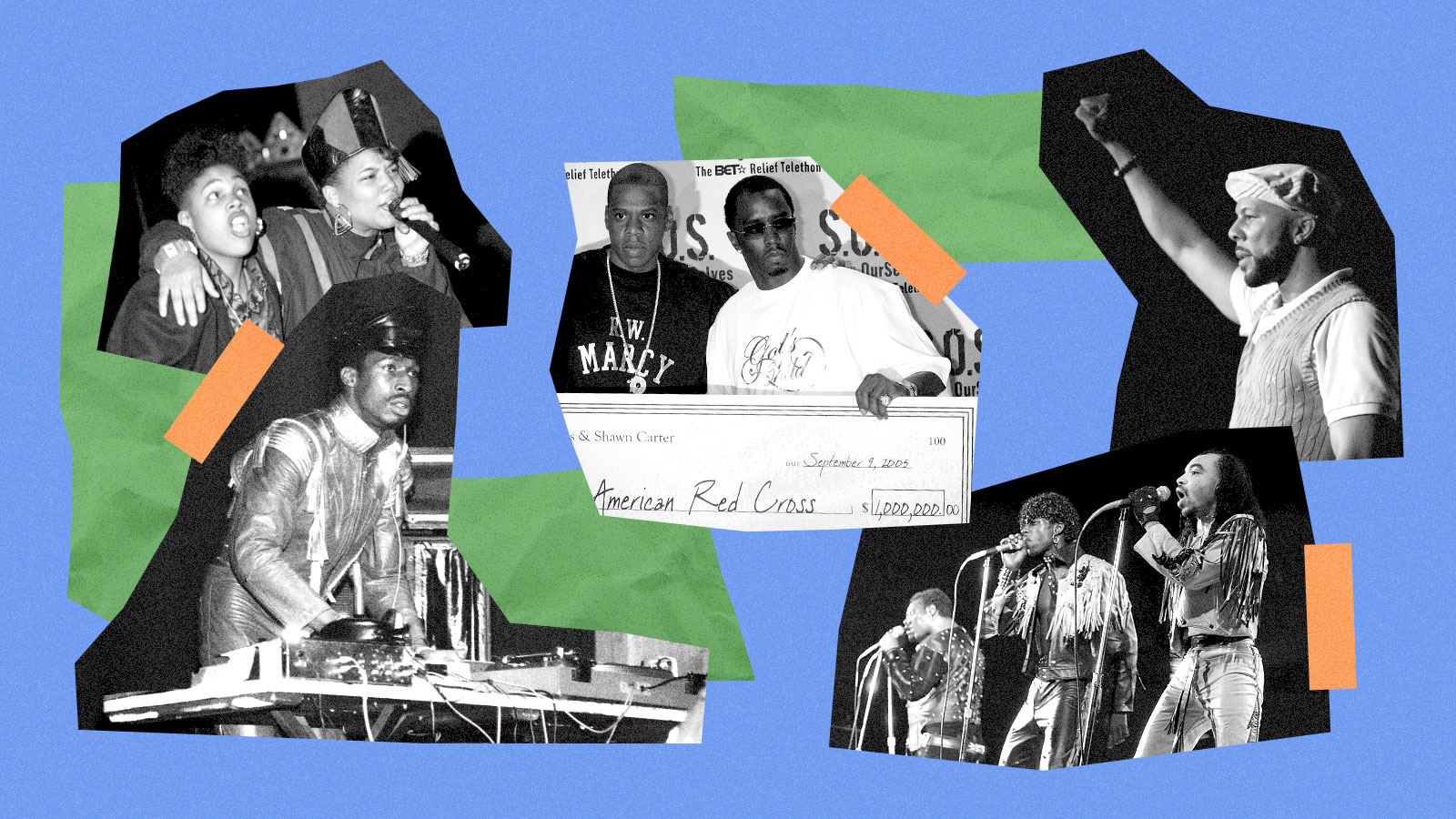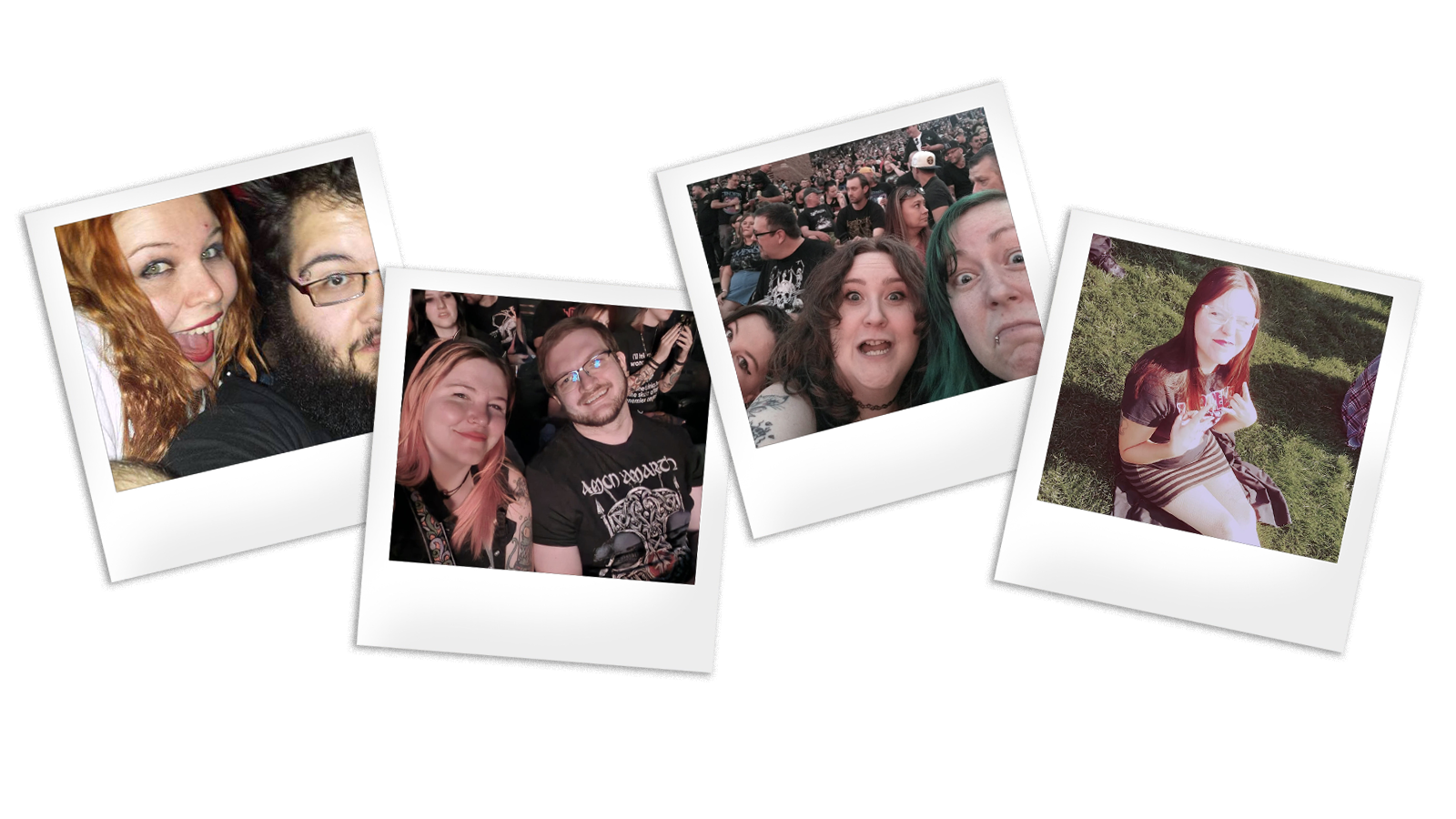Loud, angry, and Indigenous: Heavy metal takes on colonialism and climate change

The crowd sways like starlings in murmuration as we wait for the show to start. The relaxed vibe belies the pandemonium about to be unleashed. Metal concerts are like that. To an outsider, they appear violent, and they can be, but to fans like me they are a place of solace.
I’ve been attending concerts since I was a teenager; the first was in a dusty parking lot and I never looked back. At the time, I gave no thought to what amplifiers cranked to 10 might do to my hearing, and it didn’t help that I liked being close to the action. Tonight, in Denver, I’ve got earplugs, sensible sneakers, and, because it has been acting up, a brace on my knee.
The lights dim and my pupils dilate. The band starts and my adrenaline spikes. The music is loud, but I don’t care. I push toward the stage, the sound becoming a roar, thrumming in my ears. A circle opens in front of me. I’ve reached the pit, where dozens of bodies swirl in a vortex, pushing and colliding with each other in a communal dance called moshing that is both an individual act of catharsis and a collective expression of emotion.
Excitement pounds in my chest. It’s been another rough day, in a series of rough days. I’m Arapaho and Shoshone. And like all Indigenous peoples, our land is exploited, our sovereignty denied, our future imperiled. But it’s the accumulation of everyday microaggressions that make me angry. I not only live with this, I write about it, and I can’t help but get mad.
I jump in.
The ongoing brutality committed against Indigenous peoples — land grabs, genocide, continuing disregard for self-determination and sovereignty — bolster a culture of over-consumption and play an undeniable role in the climate crisis. Given that anger is a hallmark of heavy metal, it isn’t surprising that an Indigenous audience would find it appealing.
Although often associated with Satan, swords, and sorcery (and illegible logos), metal has always reflected on the environment and the state of the world. Indigenous bands have been part of the scene almost from its start more than five decades ago, but the past few years have seen a growing number of Native musicians writing about a wide range of subjects, from rurality to discrimination to the universal experience of having a good time despite all of that.
Metal is famously opaque, with around 70 subgenres, but it is almost universally accepted that everything started with Black Sabbath in 1968. Even as that British quartet was laying the foundation, XIT, pronounced “exit,” was singing about the Indigenous experience on its 1972 album Plight of the Redman.
XIT, once deemed the “first commercially successful all-Indian rock band,” sang frankly and expressively about colonization, poverty, and the loss of Indigenous traditions. Its politics and performances at American Indian Movement rallies prompted FBI attempts to suppress its music, but that didn’t keep XIT from touring Europe three times and appearing with bands like ZZ Top. Although their best music is delightfully of the ‘70s, it remains radical stuff.
Winterhawk, led by Cree vocalist and guitarist Nik Alexander, explored similar themes in 1979 on Electric Warriors, an anti-colonial, pro-environmental message that could have been written today. “Man has his machines in mother earth, murdering the balance weaved destruction in our doom,” Alexander sang on “Selfish Man.” The song interrogates whether nuclear energy is worth destroying the land: “They say nuclear power is alright, like light to make the night bright. But it doesn’t mean you can have my birthright, does it, selfish man?” (Then, as now, Indigenous peoples were at the forefront of opposition to nuclear power.) The band was popular enough to perform with the likes of Van Halen and Motley Crue and earned a slot at the US Festival in 1983, but broke up a year later.
As the 1970s gave way to the 80s, metal began splintering as bands like Metallica and Brazil’s Sepultura took it beyond the blues-based sound hard rock and metal were based upon. Testament, founded in 1983 and led by Chuck Billy, a member of the Hopland Band of Pomo Indians, sang about climate change on the 1989 album Practice What You Preach. In the song “Greenhouse Effect,” he refers to rainforests burning and “the world we know is dying slow” before singing “seal the planet’s fate, crimes they perpetrate, wasting precious land. It’s time to take a stand” in the rollicking chorus. Still, Billy doesn’t think many took the message to heart. “Twenty-five years later, everybody in the world realizes that, ‘Hey! Our climate has changed,’” he told Radio Metal.
While Testament spoke to the issue broadly, Resistant Culture, an inter-tribal band that started in the late 1980s (when it was called Resistant Militia), speaks to its specific impacts on Indigenous people. Its music combines punk and metal with traditional Indigenous singing and the band, which is unapologetically political (one verse in “It’s Not Too Late,” released in 2005, includes the line “your heroes are my enemies, your philosophy wants us dead”), discourages overconsumption while promoting equitable sustainability, self-sufficiency, and self-determination. “The more independent of the system we can be, the less power it will have over our lives and communities and the more resilient we’ll be as we approach an uncertain future,” the band, which speaks as a collective in interviews, told the music blog Blow the Scene.
Nirvana’s 1991 album Nevermind pushed grunge into the cultural mainstream. But metal did not die, it evolved. The two decades that followed saw it atomize into dozens of subgenres with different vocal styles, tempos, sonic textures, and lyrical themes. Indigenous bands were in lockstep with this global explosion, with bands like Mi’Gauss exploring their heritage on Algonquin War Metal, and Brazil’s Corubo addressing anti-colonialism and environmentalism in songs often sung in the Guarani language. Although Sepultura is not an Indigenous band, it worked with the Xavante Indigenous community on the album Roots, an exploration of Brazil’s history with colonization. Biipiigwan explicitly critiques the impact of Canada’s governmental policies on tribal communities.
Metal has, in recent years, grown more explicitly concerned with climate and the environment, with pagan- and folk-infused bands bringing an element of spirituality and pre-colonial romanticization. Pre-colonial Scandinavian bands like Warundra explore traditional Pagan worship that was the norm before Christianity. This connection with nature is more than vague gestures to a pan-Pagan past, according to Kathryn Rountree, an anthropologist at Massey University who wrote a paper on the topic. For Indigenous peoples, it is “connected to this-worldly social and political concerns.”
I’m in the pit when I fall and bang my head on the floor. Strangers immediately help me back to my feet, but someone with a strong shoulder and a rogue elbow sends me down once again. Ouch. I throw myself deeper into the fray, shoving my shoulder into someone twice my size. They shove back, but I hold my footing.
To civilians, the pit looks chaotic. But it has a current, ebbing and flowing with the music and the emotions of the audience. I move against the crowd because it’s more fun that way. My cheek is sore from yet another fall earlier in the night. Few thoughts go through my head. I just want to move; feel something.
The pit is one of the few places where being aggressive doesn’t make me seem like an angry Indian. I am angry, but metal concerts are about more than aggression. They’re about being able to express yourself, release frustration, and feel something akin to power. As an Arapaho and Shoshone from the Wind River Reservation, it’s nice to feel like I have some of that.

There’s an argument to be made that metal is the most expansive and inclusive genre of music, with bands from scores of nations and backgrounds. Alien Weaponry infuses its music with Te Reo Māori, the Indigenous language of Aotearoa New Zealand, and explores Māori culture, history, and socio-political themes. The Hu incorporates traditional Mongolian instruments and throat singing in a style of music they call Hunnu rock inspired by ancient tribes.
Women are an increasing presence in Indigenous metal. Blitz is a one-woman band started by a musician who goes by the name Evil Eye. In addition to incorporating tribal music, she draws influence from bluegrass and classical. Singer-songwriter Sage Bond combines acoustic guitar with metal in compositions that often draw from Navajo creation stories and her own experiences to comment on justice, resilience, and unity in the face of systemic racism. Takiaya Reed and Sylvie Nehill of the Australian band Divide and Dissolve write slow, almost trudging, highly experimental and occasionally dissonant instrumental music. Their music has been called “an organic release of anger” and “an excavation of buried horrors.”
Indigenous bands come from all parts of the United States, but Navajo Nation has a particularly vibrant community, with bands like Signal 99, Mutilated Tyrant, and Morbithory — the unholy trinity of Diné metal. Filmmaker and professor Ashkan Soltani Stone spent five years there, an experience he recounts in the book Rez Metal: Inside the Navajo Nation Heavy Metal Scene. He found a tight-knit community of musicians who focus on environmental issues and the experience of living in Indian Country, but also refuse to be pigeonholed. “Everybody expects them to be political and deal with very serious topics,” he said. “But in my opinion, they are just badass musicians.”
Not a lot happens in rural communities, and for many Indigenous youth, metal provides an antidote to boredom. Much of the live music is country, and getting to a concert often requires a long drive. Stone said many bands simply want to create a lively local scene, have some fun, and travel. “They are just like everyone else,” he said. “They are stuck on a reservation where there are not many opportunities. But the music is there.”
Landyn and Ayden Liston are the first to say they started Dogs Throw Spears simply to be part of Navajo Nation’s metal scene and get into shows for free. Though Landyn said “we are the last to say what genre we are,” they jokingly call themselves “Native raw dog metal” and play a style of music called death metal — a subgenre characterized by heavily distorted guitars, growled vocals, and complex rhythms. In the short time they’ve been performing, they’ve seen the number of people attending concerts, and starting bands, balloon. “These past two years bands have been coming out of nowhere,” Landyn said.
Although the band’s raw, aggressive songs explore Indigenous identity and their community grapples with weighty issues — Landyn specifically mentioned the high rate of suicide — Dogs Throw Spears has a lot to say beyond the bad in lyrics that sometimes veer toward cryptic. The song “Veggie Tales,” for example, tells listeners, “Fresh air, safe sex, rest well, beware. Breath in, breath out, fatigue, aware.”
“Don’t just read off the surface,” Landyn said of the band’s songs.
Thriving scenes and engaging bands can be found almost everywhere. Pan-Amerikan Native Front from Chicago highlights Native battles against colonizing forces and, in its own words, “the fierce resistance indigenous peoples of the ‘Americas’ have endured throughout centuries of colonial and post-colonial occupation.” The Salt Lake City band Yaotl Mictlan blends black metal — a style marked by shrieked vocals, fast guitars, and low-fidelity sonics — with Mesoamerican instruments and languages in a style it calls “pre-Hispanic metal.” Its early work focused on the Zapatista movement in Mexico. Tzompantli, (which means “skull rack” in the Indigenous language Nahuatl) is from Pomona, California, and celebrated Aztec, Mexica, and Chichimeca history on its crushing anti-colonial album Beating the Drums of Ancestral Force. Blackbraid, the one-man black metal band led by an artist who identifies himself as “south Native,” often reflects on his relationship to the natural world and ongoing resistance to genocide and oppression.
Many of these bands are singing about all the same things XIT and Winterhawk sang about in the 1970s, including Indigenous persecution, environmental degradation, and the historical and present state of colonialism. Little has changed in 50 years, and in some cases things have grown worse. Ultimately, that may be what unites Indigenous metal bands and fans the world over. Despite coming from many tribes, communities, and countries, the destructive force of colonialism, and the degradation of the environment, is something we all share.
Documentaries, books, and articles are incredibly taken with Indigenous peoples and metal, and on some level those beyond Indigenous communities can understand how difficult it is to be Indigenous right now. Native people around the world are fighting a seemingly never-ending battle with colonialism.
That battle is physical; land and water defenders protecting their communities from energy projects are regularly abused, beaten, and killed. It is verbal; at the world’s highest offices, Indigenous self-determination remains a footnote rather than a driving force to address climate change. And it is emotional; historic and ongoing trauma leaves Indigenous communities grappling with continuing colonial oppression, and that leaves Indigenous people grappling with things like a lack of infrastructure, underfunded healthcare, and a gap in education resources.
Instead of giving into despair, metal provides a productive way to engage with the state of the world. The themes that these musicians explore are universal to the Indigenous experience. That is an awful truth, but also beautiful in its solidarity.

By the end of the night, I’m coming down off the excitement and a little sore. The pit will do that. As I get older, I know I can’t keep doing this. The exhilaration that comes with attending a concert, of being part of the crowd, takes a toll. I’ve got bruises alongside the alien tattooed on my arm, giving him a black eye. He looks worse than I do.
A sea of metal fans files out of the venue into the winter night air. I bump into someone and we start talking. I’ve always found it hard to make small talk, but we chat about the show, what bands we like, and how cold it is.
“You Native?” they ask. Taken aback, I say yes, face flushing. “Hell yeah.” They fist bump me, and disappear into the snow. I never know how to respond to something like that, but it leaves me smiling. That small connection makes the night seem a little brighter, friendlier.
The air is dry and cold but refreshing as I start the long trip home.
This story was originally published by Grist with the headline Loud, angry, and Indigenous: Heavy metal takes on colonialism and climate change on Dec 23, 2024.






